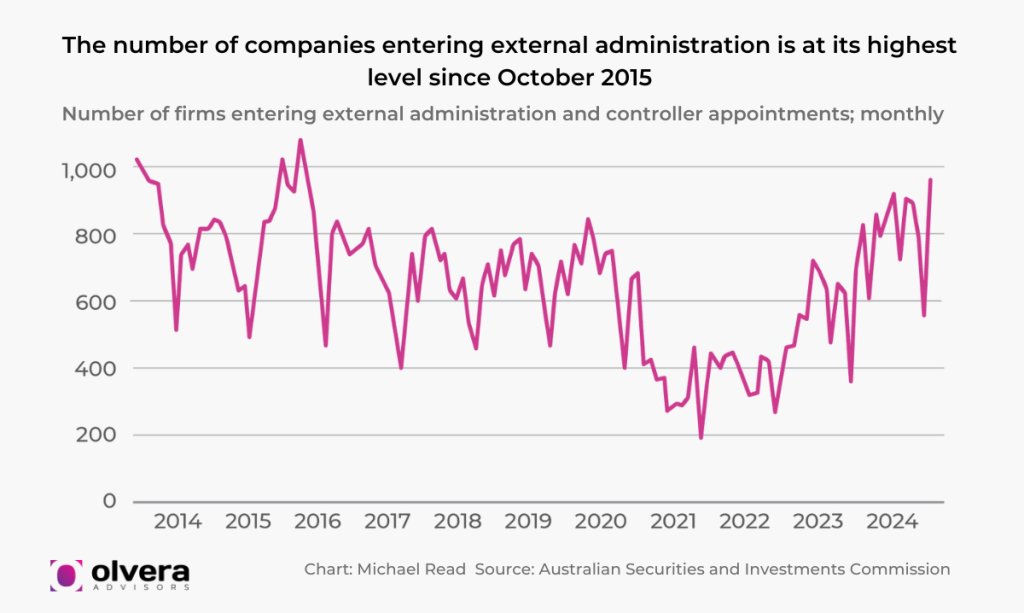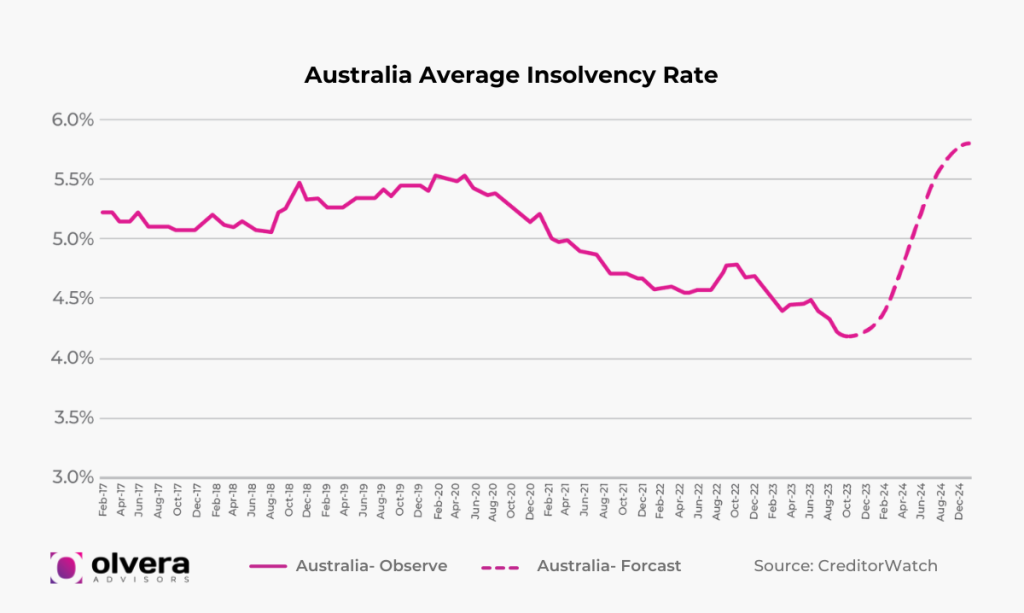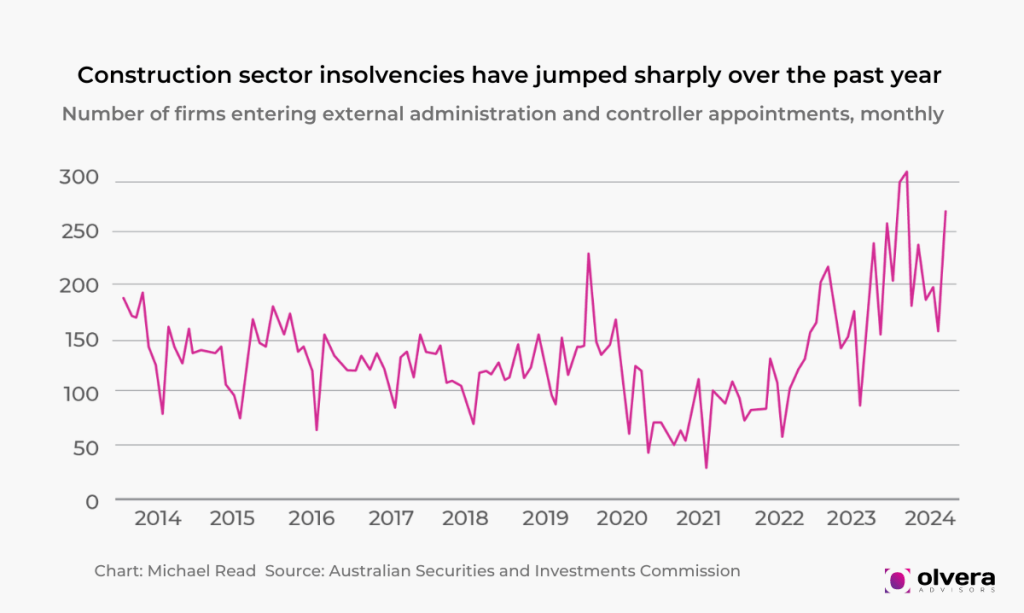The number of corporate insolvencies has spiked to a monthly high since 2015 as more companies file for voluntary administration.
Latest data from ASIC shows that 967 companies filed for insolvency in February 2024, recording a 40% jump in insolvency cases since February 2023. This is the highest number of insolvencies since October 2015, as economic pressures continue to challenge Australian businesses.

The spike in insolvency aligns with Insolvency Australia’s Corporate Insolvency Index, released at the end of last year. According to its report, administrator and controller appointments increased by 24% to 4531 in the second half of 2023. A quarter of these appointments were wound up by a court order, 113% higher than the same period in 2022.
Business-related personal insolvencies are also on the rise, as wound-up company directors face the risk of paying off company debts. Reports from the Australian Financial Security Authority claim that business-related personal insolvencies accounted for 27.3 per cent of all new personal insolvencies in the December quarter of 2023.
Insolvency forecast in the year ahead
According to CreditorWatch, business insolvencies are expected to rise in the upcoming months, citing that businesses operating at a loss will not be able to sustain another six to nine months of high–interest environment, aggressive debt-chasing, and low customer confidence.

CreditorWatch also sees record-high increases in payment defaults from business-to-business transactions (+49% YoY increase in February). This indicates a concerning trend that many businesses are facing depleting cash reserves and tightening margins.
According to CreditorWatch, the regions that pose the highest risk of business failure are around Western Sydney and South-East Queensland, with Merrylands-Guildford (NSW) and Canterbury (NSW) as the top-ranked region.
Debt-chasing a major concern
Small businesses account for most of the insolvency cases in Australia. Many self-employed businesses or those with small revenue margins must grapple with a limp economy and aggressive debt chasing by the ATO and banks.
Recently, the ATO announced that it would take stronger action against businesses that don’t fulfil their tax obligations. According to ATO’s second commissioner, Jeremy Hirschhorn, small businesses account for over two-thirds of the ATO’s collectable debt, which is currently at around $50 billion.
“During the pandemic, we took a different audit posture with individuals and small businesses, chased fewer lodgements and recovered less debt,” Hirschhorn said.
While we resumed stronger action in late 2021, we have observed a behavioural shift as to the priority of paying tax and super. We are concerned with an increased reliance on unpaid tax and unpaid super to prop up the cash flow of some businesses.”
According to the ATO, there have been more small businesses not paying tax on time since before the pandemic began. The office maintains that paying taxes is “not optional” and that businesses shouldn’t use employee entitlement monies to manage their cash flow.
In the case of banks, businesses are under pressure to settle debts owed in a high-interest environment. Although the RBA has not recently increased cash rates, business owners shouldn’t discount a possible rise.
Industry Predictions by Olvera Advisors
n a seemingly volatile market, we will see turnaround and even liquidation practices escalate this year. It’s also possible that insolvency numbers may surpass the global financial crisis era that saw more than 10,000 businesses file for insolvency.
However, many businesses are choosing to take immediate action. The number of small businesses opting for the small business restructuring (SBR) program has seen a considerable uptick, indicating a proactive approach to addressing debts.
In our experience, the ATO has been receptive to considering offers from businesses under SBR, especially if it has demonstrated a good history of meeting its tax obligations.
While many industries are affected by rising corporate insolvencies, some should be more vigilant. Operators in these three industries should pay considerable attention to risk in 2024.
Construction
Construction operators have had a tough year. The fixed contract model leaves little room for passing on higher operational costs, such as building materials and labour. We’ve seen big companies like Porter Davis enter liquidation, but many smaller builders are also feeling the pinch. As the graph below shows, the construction industry has observed a record level of corporate insolvencies.

The construction industry is also affected by low consumer demand, as fewer consumers are choosing to build because of the high material costs and interest rates. Additionally, the industry will also need to anticipate longer wait times and supply chain disruption due to geopolitical unrest.
Hospitality
The hospitality sector has yet to fully recover from the pandemic, which has seen some businesses shut down for months without revenue. While the ATO has granted relief during that time for businesses to defer their debts, businesses will now need to settle those debts while recovering their numbers to pre-pandemic levels.
This will prove challenging, considering the decreasing consumer confidence. Cost-of-living pressures will cause price-sensitive consumers to switch to cheaper alternatives or even eliminate spending altogether.
Retail
Almost 700 businesses in the retail industry went bankrupt last year, and retail trade insolvencies increased by 55% in the 12 months to February. As with hospitality, consumers are limiting their discretionary spending, which has a negative effect on the industry as a whole.
Smaller companies are at higher risk of insolvency, as they generally operate on tighter margins than bigger retail companies. 2023 saw a subdued Christmas spending than usual, and this trend could be possible at the end of this year.
Key takeaway
Acting early is key to navigating an uncertain market. Businesses that take proactive measures to change their debt structures and internal processes can stay ahead and avoid premature insolvency. With the right knowledge and market understanding, companies have a better chance in 2024.
Olvera Advisors helps businesses stay ahead in a dynamic environment with bespoke restructuring solutions. Explore our blog for more insights on navigating the financial complexities of this dynamic industry.
Reference:
- Corporate insolvencies spike to a decade high
- Businesses that survived as result of pandemic tipped to collapse in 2024
- ATO chases small businesses for $34b in debt, insolvencies tipped to hit post-global financial crisis levels
- External administrations surging across most sectors as business activity slides
- Insolvency Australia figures show court-ordered liquidations spike
- Directors of previously wound-up businesses are getting caught out through personal guarantees
- ATO, bank debt crusade triggers 133% jump in court wind-ups




